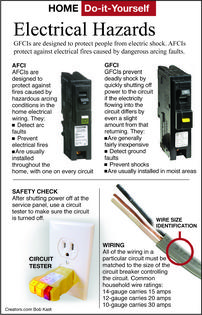Here's How: Circuit Breakers Protect House Wiring
Dear James: I am concerned about a fire from an electrical issue in my older house. What are the differences among fuses, breakers, GFCI and AFCI, and which are best? -- Peggy T.
Dear Peggy: You are wise to be concerned about an electrical fire from old or new wiring. One the most dangerous aspects of electrical fires is they often start inside a wall. They can burn and expand for quite a while before they are noticed, which can limit your time to escape.
The most common protective devices are circuit breakers and fuses. Both of these devices detect an unusually high current load and shut off the electric current when the current exceeds a certain level. Most wiring in a house is sized to safely handle 15 or 20 amperes of electric current.
When electric current flow is too high through the wiring in your house, the wires can get hot, just like toaster elements, and ignite building materials (lumber, insulation, vapor barriers, etc.) inside of the walls.
Today, most homes use standard circuit breakers in the electrical panels. They are convenient because they are simple to reset after they trip from a high electrical load. Circuit breakers can malfunction and do not always shut off a high current.
On the other hand, fuses almost always shut off the current. The element inside them literally melts when the designated current is exceeded. If you want to protect sensitive equipment, fuses are better than circuit breakers.
Ground fault circuit interrupters (GFCI) function differently. Their purpose is to detect a short circuit that can allow electricity to pass through your body to ground. It is surprising how little electrical current or voltage is required to stop a person's heart.
To help you understand, think of a GFCI as measuring the amount of electric current entering it and the amount exiting it. For example, if you are using an electric drill outdoors and less electricity is exiting through the GFCI than entering it, it assumes that there must be a ground fault through your body. It then shuts off the electricity.
The other type of common electric problem that causes fires is an arc fault. This may be caused by a loose wire at a switch, a break in the wire insulation where a nail in the wall hit it, just old kinked wire insulation, etc. This arcing or spark can ignite any combustible materials inside the wall.
When arcing occurs, the electrical current is not excessively high, so a standard circuit breaker or fuse will not detect any problems. A GFCI will not detect a problem either, because the incoming and exiting currents are the same.
There are new types of circuit breakers that incorporate an additional sensor to detect arcing. These are called arc fault circuit interrupters or breakers (AFCI). Special electronics inside it detect the changes in the current flow that are specific to arcing and shuts off the current.
You will have to go to an electrical supply outlet to find an AFCI. Most home centers do not carry them yet. At about $25, they are somewhat pricier than standard circuit breakers. Currently, there are only a few major manufacturers of them: Eaton, General Electric and Square D.
Before you run out to buy them, make sure that they will fit into your load center breaker box. Many AFCI and standard breakers are interchangeable and will fit many boxes, but you cannot be sure. Try to find ones made by the same company who made your breaker box.
It is a quick job to replace a circuit breaker with an AFCI, but it can sometimes be tricky getting the power switched off to the buss in the box. Unless you are EXTREMELY competent with electrical repairs, leave this job to an electrician.
========
Send your questions to Here's How, 6906 Royalgreen Dr., Cincinnati, Ohio, 45244 or visit www.dulley.com. To find out more about James Dulley and read features by other Creators Syndicate writers and cartoonists, visit the Creators Syndicate website at www.creators.com.
Copyright 2024 Creators Syndicate Inc.






























Comments